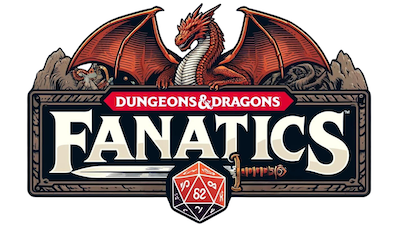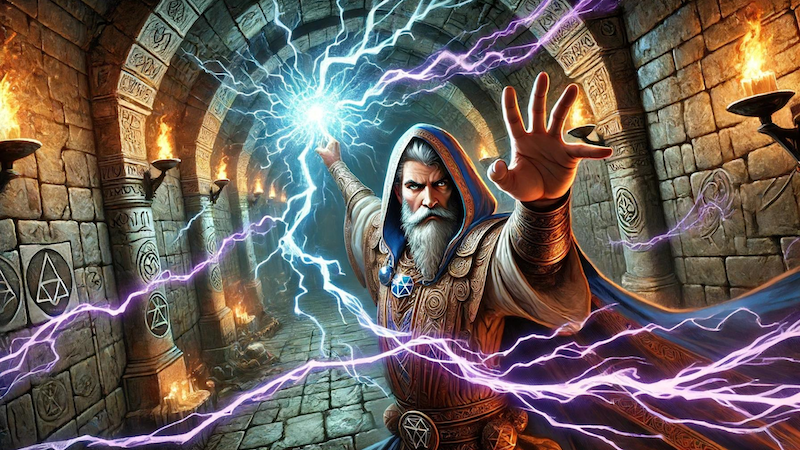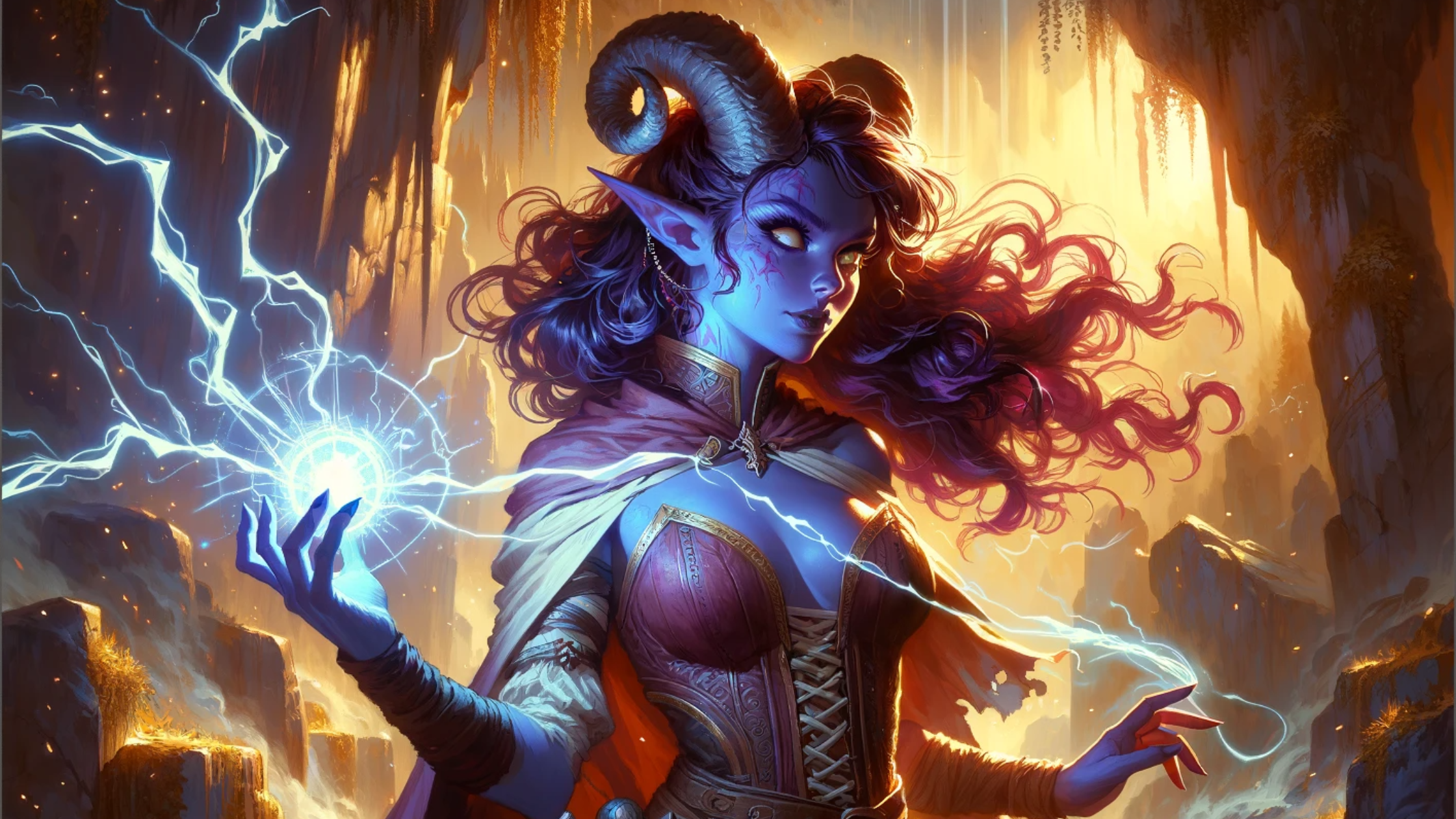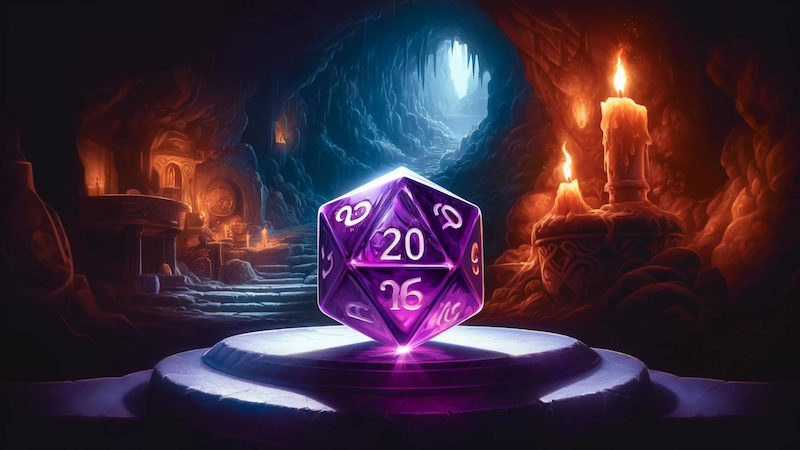

The Warlock: DnD 5e Class Guide (Updated June 2024)
As an Amazon Associate I earn from qualifying purchases.
The whispers of the Shadow King swirled through Lucien’s mind as he finished the incantation. An instant later, dark tendrils of energy burst from his fingers, lashing out and gripping the throat of the bugbear chief. The creature’s terrified shrieks filled the air as its feet were lifted off the ground and its life force slowly began to fade. The whispers of the Shadow King drifted back into the void, a dark hunger waiting to be called forth again.
Table of Contents
- What is a Warlock in DnD 5e?
- What is a Warlock’s primary ability score?
- What is a Warlock’s hit die and hit points?
- What are Warlocks proficient in?
- What equipment do Warlocks start with?
- What unique features do Warlocks have?
- How does Warlock spellcasting work?
- What are the Warlock subclasses?
- What species are best for Warlocks?
- How do you roleplay a Warlock?
- What DnD 5e sourcebooks do Warlocks appear in?


What is a Warlock in DnD 5e?
Wielders of ancient eldritch power, Warlocks are one of the more unusual of all DnD 5e classes. Unlike Wizards, who study and memorize arcane lore, or Sorcerers, who possess innate magical gifts, Warlocks gain their spellcasting abilities from dark pacts forged with mysterious and otherworldly Patrons. These Patrons can be ancient beings, powerful fiends, enigmatic fey or even cosmic horrors from beyond the stars.
This unique relationship allows Warlocks to access spells and powers that other magic users cannot, which is reflected in their use of Eldritch Invocations (spells granted by their Patrons) and Pact Boons (providing unique abilities to shape arcane energy). The result is a class that is both deeply customizable and rich with roleplaying opportunities.
Below is the Warlock class table, which breaks out proficiency bonuses, features, spell slots and invocations.
| Warlock Class Table | |||||||
|---|---|---|---|---|---|---|---|
| Level | Proficiency Bonus | Features | Cantrips Known | Spells Known | Spell Slots | Slot Level | Invocations Known |
| 1st | +2 | Otherworldly Patron, Pact Magic | 2 | 2 | 1 | 1st | – |
| 2nd | +2 | Eldritch Invocations | 2 | 3 | 2 | 1st | 2 |
| 3rd | +2 | Pact Boon | 2 | 4 | 2 | 2nd | 2 |
| 4th | +2 | Ability Score Improvement | 3 | 5 | 2 | 2nd | 2 |
| 5th | +3 | 3 | 6 | 2 | 3rd | 3 | |
| 6th | +3 | Otherworldly Patron feature | 3 | 7 | 2 | 3rd | 3 |
| 7th | +3 | 3 | 8 | 2 | 4th | 4 | |
| 8th | +3 | Ability Score Improvement | 3 | 9 | 2 | 4th | 4 |
| 9th | +4 | 3 | 10 | 2 | 5th | 5 | |
| 10th | +4 | Otherworldly Patron feature | 4 | 10 | 2 | 5th | 5 |
| 11th | +4 | Mystic Arcanum (6th level) | 4 | 11 | 3 | 5th | 5 |
| 12th | +4 | Ability Score Improvement | 4 | 11 | 3 | 5th | 6 |
| 13th | +5 | Mystic Arcanum (7th level) | 4 | 12 | 3 | 5th | 6 |
| 14th | +5 | Otherworldly Patron feature | 4 | 12 | 3 | 5th | 6 |
| 15th | +5 | Mystic Arcanum (8th level) | 4 | 13 | 3 | 5th | 7 |
| 16th | +5 | Ability Score Improvement | 4 | 13 | 3 | 5th | 7 |
| 17th | +6 | Mystic Arcanum (9th level) | 4 | 14 | 4 | 5th | 7 |
| 18th | +6 | 4 | 14 | 4 | 5th | 8 | |
| 19th | +6 | Ability Score Improvement | 4 | 15 | 4 | 5th | 8 |
| 20th | +6 | Eldritch Master | 4 | 15 | 4 | 5th | 8 |


What is a Warlock’s Primary Ability Score?
Charisma is a Warlock’s primary ability score. Your character must have a Charisma of 13 to multiclass as one. This reflects the fact that a Warlock’s magic is derived from their pact with their Patron, requiring a strong force of personality and the ability to negotiate and wield destructive arcane power.
The higher your Charisma score, the more potent your Warlock’s spellcasting abilities become, enhancing your spell attacks and saving throws. This is particularly crucial at higher levels as it directly impacts the effectiveness of your eldritch invocations and spells.
Additionally, Warlocks gain a saving throw proficiency in Wisdom, reflecting your attunement to the often incomprehensible and maddening forces of your Patron and your tireless search for the dark secrets of the multiverse.


What is a Warlock’s Hit Die and Hit Points?
Warlocks have 1D8 hit dice per level. This means at 1st Level your Warlock’s hit points will be 8 + your Constitution modifier. Each level you advance from Level 2 onwards, you gain an additional 1D8 (or an average of 5) Hit Points, plus your Constitution modifier.
This Hit Dice breakout makes Warlocks more resilient than other magic users, particularly Sorcerers and Wizards, who each have only a 1D6 Hit Die. While not as robust as martial classes like Fighters and Barbarians, the Warlock’s 1D8 Hit Die puts them in the same league as Artificers, Bards, Clerics, Druids, Monks and Rogues, allowing for versatile spellcasting with the ability to also handle a decent amount of combat.
That being said, Warlocks can still be a little “squishy,” particularly at early levels, so you may want to consider going with a higher Constitution score if you’re planning on taking a subclass that relies more on melee weapons (such as the Hexblade Warlock).


What are Warlocks Proficient In?
Warlocks have a unique set of proficiencies that reflect their relationship with both magic and the otherwordly Patrons they serve.
- Armor: Light armor
- Weapons: Simple weapons
- Tools: None
- Saving Throws: Wisdom and Charisma
- Skills: Choose two from Arcana, Deception, History, Intimidation, Investigation, Nature and Religion


What Equipment Do Warlocks Start With?
As a Level 1 Warlock, you begin your adventures with the following equipment:
- A light crossbow and 20 bolts or any simple weapon
- A component pouch or an arcane focus (such as a feather, talisman or symbol associated with your Patron)
- A scholar’s pack or a dungeoneer’s pack
- Leather armor, any simple weapon and two daggers


What Unique Features Do Warlocks Have?
Warlocks are able to access a range of unique abilities and powers that reflect the pact they have made with their Patron and the study of magic itself. This includes:
- Eldritch Invocations: At 2nd level, you gain two eldritch invocations of your choice (these are special magical abilities granted by your Patron). When you gain Warlock levels, you gain additional invocations of your choice, as shown in the Invocations Known column of the Warlock Class Table above. When you gain a level, you can also choose one of the invocations you know and replace it with another invocation of the same level.
- Pact Boon: At 3rd level, you gain one of the following features of your choice.
- Pact of the Blade: You can use your action to summon a magical melee weapon, which you are always proficient in. Your pact weapon disappears if it is more than 5 feet away from you for 1 minute or more. It also disappears if you use this feature again, if you dismiss the weapon or if you are killed. Alternatively, you can transform one magical, non-sentient weapon into your pact weapon by performing a special 1-hour ritual. You can then dismiss and summon the weapon at will. You can also create a new weapon by performing the ritual again (the old weapon will no longer be a pact weapon and will then teleport at your feet).
- Pact of the Chain: You learn the find familiar spell and can cast it as a ritual. The spell doesn’t count against your number of spells known. When you cast the spell, you can choose one of the normal forms for your familiar or one of the following special forms: imp, pseudodragon, quasit or sprite. Additionally, when you take the Attack action, you can forgo one of your own attacks to allow your familiar to make one attack with its reaction.
- Pact of the Tome: Your Patron gives you a grimoire called a Book of Shadows. When you gain this feature, choose three cantrips from any class’s spell list (the three don’t have to be from the same list). While the book is on your person, you can cast those cantrips at will. They don’t count against your number of cantrips known. If they don’t appear on the warlock spell list, they are nonetheless Warlock spells for you. If you lose your Book of Shadows, you can perform a 1-hour ceremony to receive a replacement from your Patron. This ceremony can be performed during a short or long rest, and it destroys the previous book. The book turns to ash when you die.
- Pact of the Talisman: Your Patron gives you a talisman that can aid yourself or another wearer. When the wearer fails an ability check, they can add a d4 to the roll, potentially turning the roll into a success. This benefit can be used a number of times equal to your proficiency bonus, and all expended uses are restored when you finish a long rest. If you lose the talisman, you can perform a 1-hour ceremony to receive a replacement from your Patron. This ceremony can be performed during a short or long rest, and it destroys the previous amulet. The talisman turns to ash when you die.
- Mystic Arcanum: At 11th level, choose one 6th-level spell from the Warlock spell list. You can cast this spell once without expending a spell slot. You must finish a long rest before you can do so again. At higher levels, you gain more Warlock spells of your choice that can be cast in this way: one 7th-level spell at 13th level, one 8th-level spell at 15th level, and one 9th-level spell at 17th level. You regain all uses when you finish a long rest.
- Eldritch Master: At 20th level, can spend 1 minute entreating your Patron for aid to regain all your expended Warlock spell slots. Once you regain spell slots with this feature, you must finish a long rest before you can do so again.


How does Warlock Spellcasting Work?
Unlike Wizards (who have to memorize their spells) or Sorcerers (who draw their power from innate abilities), as a Warlock, your spellcasting ability is granted by your pact with an otherworldly Patron.
Warlocks also have a set list of known spells which are taken from the Warlock Spell List. Each of these spells must be of a level for which you have spell slots. You can only cast spells which you know, although when you gain a level, you can swap out a known spell for a new spell (with your Dungeon Master’s approval).
Charisma is a Warlock’s primary spellcasting ability as follows:
- Spell save DC = 8 + your proficiency bonus + your Charisma modifier
- Spell attack modifier = your proficiency bonus + your Charisma modifier
Warlocks also gain Eldritch Invocations, which are special abilities granted by your Patron that provide additional spell-like effects or enhancements.
Notably, in DnD 5e magic users are broken out into “full casters” (Bards, Clerics, Druids, Sorcerers and Wizards) who progress at the same speed in terms of spell level and “half-casters” (Paladins and Rangers) whose spell level progression moves at half the speed of full-casters.
Warlocks, however, are tehnically considered “third casters” as they have a limited number of spell slots that recharge on a short or long rest and are always at the highest level they can cast. This gives them a distinctive place in the spellcasting hierarchy, with their style of magic referred to as “Pact Magic.”


What are the Warlock Subclasses?
Currently, there are 9 official Warlock subclasses for DnD 5e, representing the Patron you choose to serve. You select your subclass/Otherworldly Patron at Level 1 (which is somewhat different than other classes, who typically choose their subclass at level 3).
- Archfey: You have made a pact with a powerful being of the Feywild, gaining powers that enchant and bewilder. This subclass provides you with abilities to charm and frighten others, teleport short distances and manipulate the minds and emotions of those around you.
- Celestial: Your patron is a creature of good, imbuing you with powers of healing and radiance. This subclass allows you to cure wounds, channel celestial energy into destructive power and provide resilience against death for you and your allies.
- Fathomless: Bound to a mysterious entity from the watery depths, you command the crushing pressure and cold darkness of the sea. This subclass grants you tentacle attacks, watery teleportation and the ability to breathe underwater as well as resist cold.
- Fiend: Your patron is a creature of the lower planes, bestowing upon you the ability to channel fiery wrath and curses upon your foes. This subclass enhances your resilience, provides bonuses to certain types of spells and allows you to temporarily gain hit points when you reduce a foe to 0 hit points.
- Genie: You serve a powerful genie, gaining magic that reflects the genie’s elemental nature—be it air, fire, earth or water. This subclass allows you to craft a magical vessel linked to your genie, gain resistance related to your genie’s type and manipulate the battlefield with elemental power.
- Great Old One: Linked to a mysterious, otherworldly entity, your powers include telepathy and mental manipulation. This subclass provides you with the ability to communicate thoughts, sow madness among your enemies and protect your mind against intrusions.
- Hexblade: You are connected to a magical weapon borne from the Shadowfell, which grants you combat prowess and the ability to curse your foes. This subclass enhances your melee capabilities, allows you to use charisma for weapon attacks and provides spells related to combat and protection.
- Undead: You derive your power from a bond with the undead, embracing necrotic energies and manipulating the forces of death. This subclass allows you to adopt ghostly traits, terrify your enemies and eventually even defy death itself.
- Undying: Your patron is an immortal being who has mastered the secrets of longevity, sharing with you the magic of endurance and preservation. This subclass gives you abilities to avoid death, resist disease and restore health.


What Species are Best for Warlocks?
While any race can be a Warlock, in general, those that boost Charisma scores tend to be ideal for this class. Here are a few top choices:
- Half-Elf: Half-Elves are a popular choice for Warlocks due to their +2 Charisma bonus and the flexibility to increase two other ability scores by 1. Their Fey Ancestry trait also grants advantage on saving throws against being charmed and immunity to magical sleep, which can be particularly useful in avoiding certain enemy effects.
- Tiefling: Tieflings receive a +2 Charisma bonus, making them naturally inclined towards Warlock abilities. Their infernal heritage grants them resistance to fire damage and access to racial spells like Hellish Rebuke and Darkness, which can enhance a Warlock’s spell repertoire.
- Aasimar: Aasimar can choose to gain a +2 bonus to Charisma and have access to racial abilities that complement their spellcasting, such as healing or dealing radiant damage. Their Celestial Legacy provides additional utility and support, aligning well with the Warlock’s abilities.
- Human: Humans’ flexibility and versatility make them a great choice for almost any class, including Warlocks. The ability to increase both Charisma and Constitution scores can provide a solid foundation for both spellcasting and durability.


How Do You Roleplay a Warlocks?
When it comes to roleplaying a Warlock, there are a limitless number of options and they’re definitely a class that offers a ton of storytelling potential. That being said, if you’re looking for some ideas, here are a few concepts to get you started:
- Reluctant Servant: Your pact was made under duress or by accident, and you find yourself bound to a Patron you neither trust nor fully understand. You must now navigate this uneasy alliance, attempting to break free or find a way to mitigate the influence your patron holds over you.
- Dark Scholar: Fascinated by forbidden knowledge and the occult, you sought out your Patron to gain access to hidden truths and arcane secrets. You may be seen as an eccentric or dangerous figure, constantly pushing the boundaries of what is known and risking the consequences of your curiosity.
- Redeemed Outcast: Once a member of a dark cult, you now seek redemption and a new path. Your Patron’s power is a reminder of your past, and you must now balance the desire to atone for previous misdeeds with the call of the dark powers at your disposal.
- Fey-Touched Wanderer: Your pact with a capricious fey patron grants you magic that reflects the unpredictable nature of the Feywild. You now struggle to understand and control the influence of the Fey that grants you incredible powers but is also changing your mind, body and spirit.
- Haunted Avenger: Your pact was forged out of a desperate need for revenge. Perhaps a loved one was taken from you, and your Patron offered the power to avenge them. Yet as you seek justice, you wonder if the cost of your newfound powers will be more than you can bear.


What DnD 5e sourcebooks do Warlocks appear in?
While the Warlock is a base class, it’s also relatively new in Dungeons & Dragons, having first been introduced in supplementary materials for DnD 3.5. The class, however, has changed a great deal since it first appeared. Below are the sourcebooks which contains all the official rules for Warlocks in DnD 5e.
- Player’s Handbook: Includes base Warlock class, plus the Archfey, Fiend and Great Old One.
- Sword Coast Adventurer’s Guide: The Undying.
- Xanathar’s Guide to Everything: The Celestial and Hexblade.
- Tasha’s Cauldron of Everything: The Fathomless and the Genie.
- Van Richten’s Guide to Ravenloft: The Undead.
More D&D News Coverage
For more from the world of Wizards of the Coast, visit our D&D News page.







